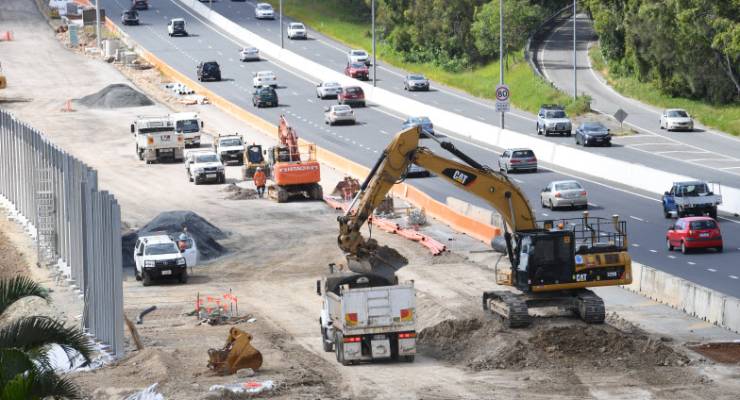
Every government in Australia’s modern history has been able to point to one solid area of economic achievement. All, that is, except the current administration. Building and engineering construction — until the last three years — has always expanded steadily, despite floods, droughts, wars, recessions, depressions and Gough Whitlam.
By building new shopping centres, skyscrapers, housing estates, factories, offices, farms and mines, the construction sector has always generated jobs, wages, profits and wealth for the nation. Until now.
Construction in an unprecedented slump
Wednesday’s figures from the Australian Bureau of Statistics (ABS) show building and construction investment has now declined for three financial years in a row. That has never happened before. In fact, only twice since records have been kept have there been even two consecutive annual declines. The first was in 1982 and 1983 during the worldwide recession following the US savings and loans crisis. The second was in 1991 and 1992 at the depths of the early 1990s global recession.
There was a small quarterly rebound in June, as hoped. But the annual total to June 2017 is well below the full year to June 2016. This is an extraordinary result, given last year was well below the full year before.
Private sector construction
Construction in the private sector is where about 80% of the output occurs. This decreased in the 2016-17 year [Table 1, column Q] for the third consecutive year — for the first time ever.
Disturbingly, the rate of the decline has increased each year. Private building and construction fell by 4.9% in 2014-15, then by 6.5% the following year. This year’s decline was an alarming 8.0%.
This is despite a bit of a surge in the June quarter to $40.86 billion. But even that quarter’s level is well below the average quarterly investment through the last 10 quarters of the Labor period — which was $42.62 billion.
Government sector
Construction by the government sector recovered in 2016-17 from the previous two aberrantly low years to $40.7 billion. Any rebound is, of course, always most welcome. But this is still a long way from the levels between 2008 and 2014 — which averaged $45.7 billion.
Total private and public construction for the full financial year to June was measured at just $192.3 billion, the first year below $200 billion since 2010-11, at the depths of the global financial crisis.
What is going on?
Explanations include the collapse in demand for housing due to real wage declines, volatile business confidence, a slow-down in investment from overseas and the lack of public funds for infrastructure due to the severe shortfall in tax revenue. This is due almost entirely to widespread tax avoidance.
Business failures
The knock-on effects of the slump in building and construction are several. They include job stagnation, lower household incomes, subdued GDP growth, the loss of national net worth, lower company revenue and business collapses.
Construction companies relying solely on construction are struggling badly. More than 30 have gone into liquidation or receivership this year just in Queensland alone.
Australia’s largest public construction company, Lend Lease Group, has just reported its annual profit, which was up an impressive 17% on last year. This is because of buoyant construction in all countries in which it operates, except one. In Australia, gross earnings were “down 13 per cent to $201.4 million during the year”.
There are two somewhat puzzling postscripts to this week’s highly negative construction data from the ABS.
Expectations unfulfilled
The first is that the Coalition actually set out to make construction the centrepiece of its economic program. Before the 2013 election, Liberal leader Tony Abbott assured the nation repeatedly that:
“I would like to be, should I get the chance, a prime minister who revels in seeing cranes over our cities, who revels in seeing bulldozers at work and who revels in seeing water coming from where it flows to where it’s needed. That is the kind of prime minister that I would like to be if I get the chance.”
Global recovery
The second is that Australia and the world are now in a period of extraordinary growth in global trade and a surge in corporate profits. Now should be the time for construction to be enjoying a record boom, rather than suffering an all-time record slump.








Economic Wizards performing at their best….bring back Labor, they can act as well as talk….
Ummm… “(the construction sector) By building …, factories, …, farms” – could someone remind me the last time this country built a “factory”, y’know, somewhere that kinda-sorta made ‘stuff’?
And how does this miracle working cohort “build a farm”? As Samuel Clemens pointed out re land ‘..they ain’t making it anymore”.
Building more offices & shopping centres, the ultimate in phantasy make-work, does not contribute one iota to the common weal.
Offices shuffle paper, shopping centres only function to churn money (remember that stuff?) earned, if not generated, in doing something worthwhile.
All else, esp “financial services” is an economy based upon “taking in each others laundry”, aka eating the seed corn.
Duh – we have an incompetent Coalition at the helm.